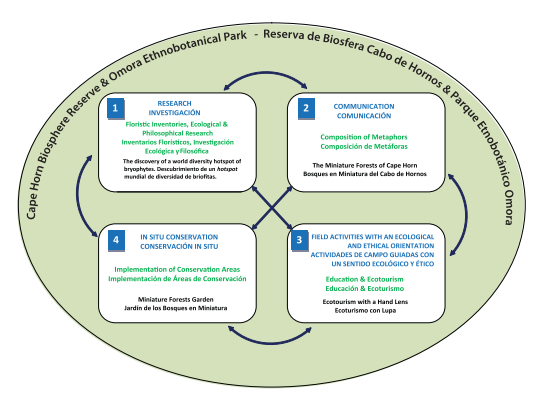The Omora Ethnobotanical Park has developed a four-step cycle linking research and
conservation. Each step (circles) is illustrated according to the method used (green,
italics), and the progress made (black) toward conserving a particular aspect of biocultural
diversity in the sub-antarctic ecoregion. Arrows and lines indicate that interactions
among the four steps are multidirectional.
Step-by-step example of the Miniature Forests of Cape Horn and Tourism with a Hand Lens
Scientific research, based on floristic inventories disclosed globally outstanding richness of bryophytes (mosses and liverworts) at the southern end of the Americas, "discovered" a high diversity of these tiny plants (5% of the world's total in the Cape Horn Biosphere Reserve). However, they often lacked common names and their small size made them normally pass unperceived, which created difficulty in communicating these findings to decision makers and the general public.
Communication of this scientific discovery to government authorities and the general public was facilitated through the invention and use of metaphors such as the "miniature forests of Cape Horn", which proved useful in conveying the notion of these highly diverse biotic communities as an ecosystem, consisting of mosses and liverworts and their associated lichens, fungi, and invertebrates.
Guided field tours in the Omora Ethnobotanical Park require expertise in creating the content and narrative of the experience as well as scientists and graduate students who accompany government authorities, school teachers, members of the local community, journalists, and ecotourism groups to enjoy the miniature forests of Cape Horn. These field experiences in turn led to the concept of "tourism with a hand lens". This new type of tourism has enhanced the appreciation of ecological interactions and the beauty of the austral bryoflora, while at the same time providing a sustainable source of income for local communities in the Cape Horn Biosphere Reserve. The Chilean government has also supported this innovative idea by funding training courses and publications on the natural history of bryophytes and lichens and a general line of "scientific tourism" for the Cape Horn archipelago.
In-situ conservation of the austral bryoflora and development of "tourism with a hand lens" has stimulated an interdisciplinary team of scientists and artists to design and begin building a "garden of the miniature forests of Cape Horn" in the Omora Ethnobotanical Park. In this garden, the first of its kind worldwide, Omora is currently demonstrating that "tourism with a hand lens" is both environmentally and economically sustainable. With the help of a hand lens, visitors can spend hours observing the little-known and unusual biota, and hence stay longer in one place, thus increasing the number of nights tourists stay in local hotels and restricts environmental impacts to only a very small area (< 1 ha) of the biosphere reserve.